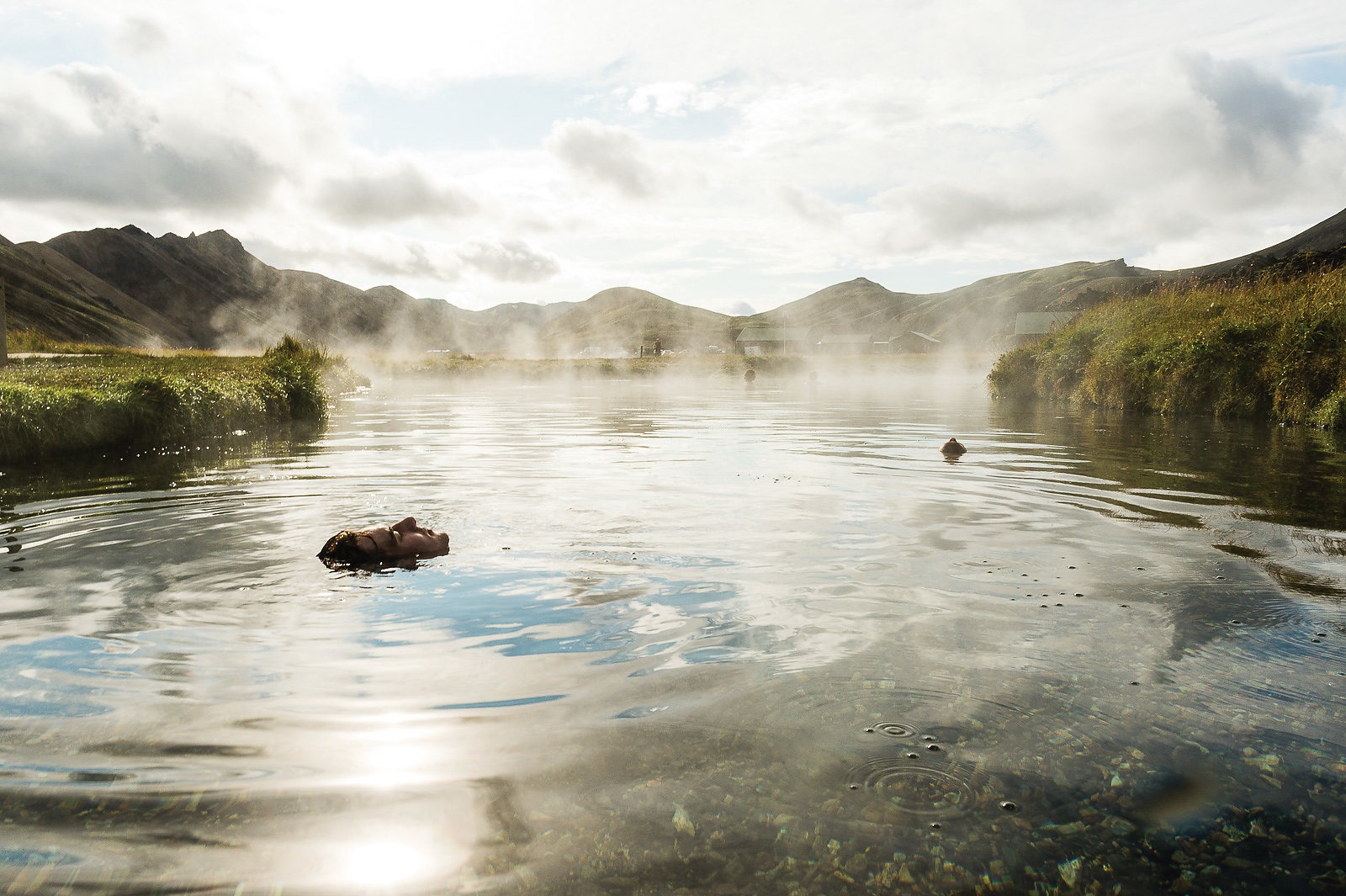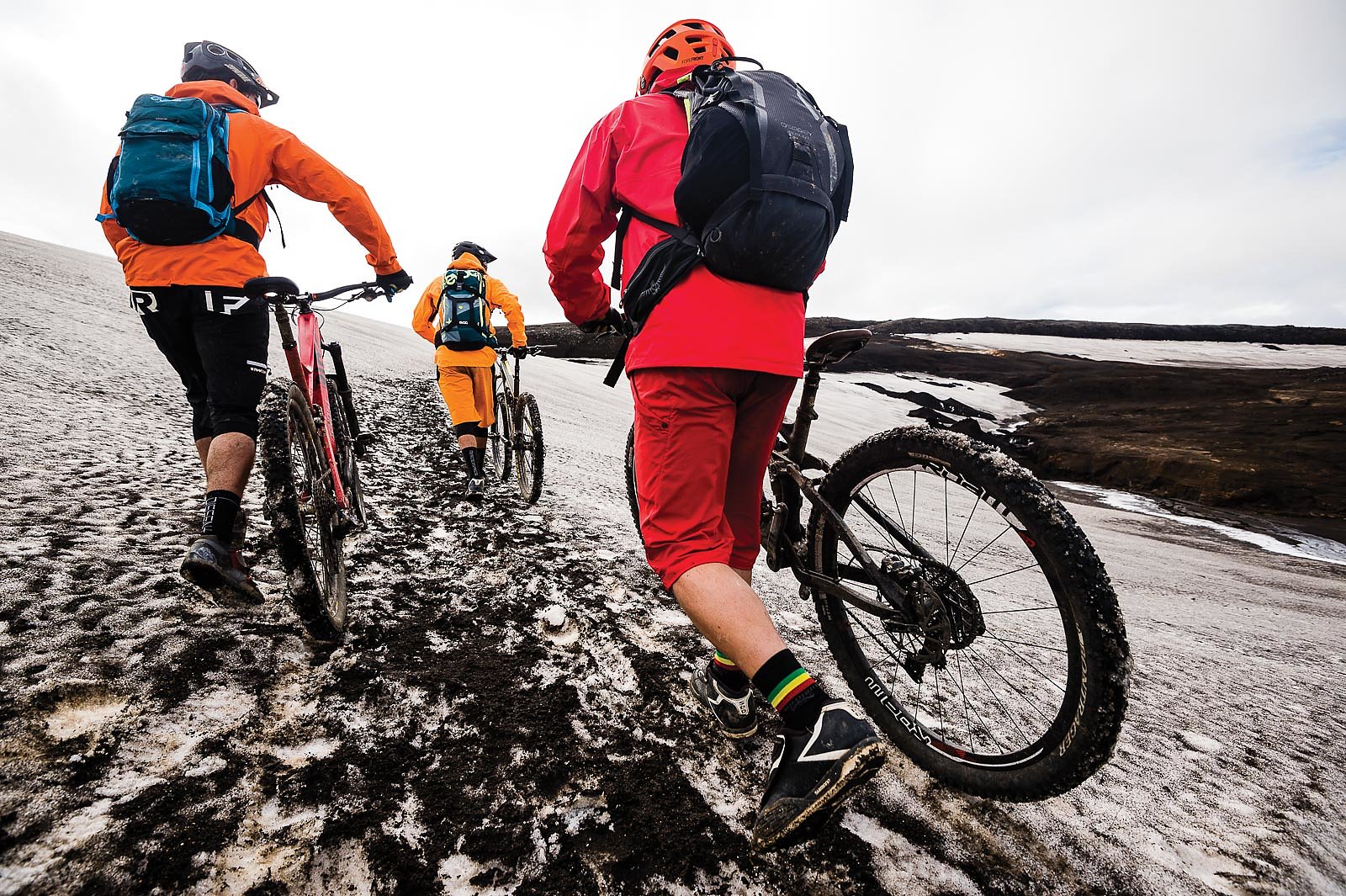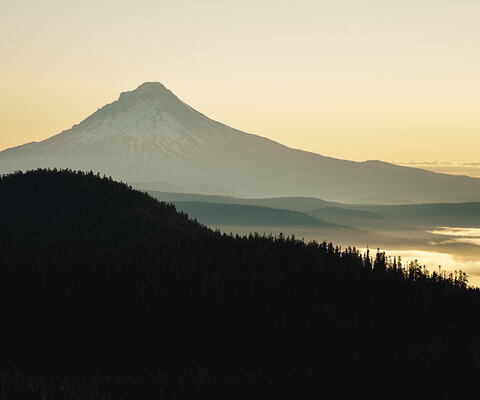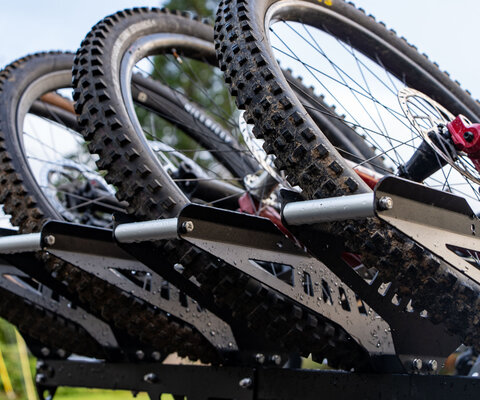
Land of Giants - Sulfur, Singletrack and Volcanic Thunder on Iceland's Laugavegur Trail
The familiar Sea-to-Sky ocean views are obscured by sodden clouds as we wind our way down from Squamish, BC towards Vancouver.
Water streams across the highway, and the glare of brake lights makes for an epileptic commute. It is late summer in Howe Sound, and the area’s torrential rains have arrived. Thankfully, however, we have an escape plan.
Chris Winter and I are driving to Vancouver International Airport to catch a flight to Reykjavik, the capital of Iceland. While it’s most likely colder on the distant island than in Squamish, it’s an area completely unknown to us and the terrain—and riding—is supposed to be surreal. The goal is a five-day, hut-to-hut bike trip through Iceland’s southern highlands along the legendary Laugavegur Trail. The trail ventures through some of the country’s most dramatic terrain, twisting over a near-alien landscape and near the sulfuric burps of geothermal vents—and, on one of the most dramatically volcanic places in the world, that’s saying a lot.
As I drag my bike box towards the Icelandair terminal, my phone rings. It’s Wade Simmons, one of the other two members of the trip. Simmons will be taking a later flight, and I expect his usual enthusiastic greeting. Instead his first words are, “Code Orange, Matthews. The Bardarbunga Volcano just erupted. Where are you guys?”

At only 17 million years old, in geological terms Iceland is a baby—much of North America can claim billions of years. This youth means the same forces that created the island’s spectacularly unique geography are still very much active. Just three years earlier the Eyjafjallajökull Volcano erupted, shutting down a huge chunk of Europe’s airspace and affecting more than 10 million people and over 100,000 flights. I have been paying close attention to international news for the past few weeks, but reports of recent volcanic activity have been mixed at best. Winter pulls out his phone to check the latest status update. “Two earthquakes measuring 5.3 and 5.1 have been detected beneath Iceland’s Bardarbunga Volcano, and a small eruption under an ice cap has begun,” says the BBC website. “Air space over the volcano has been closed, but Icelandic airports remain open.” We look at each other, wide-eyed with surprise. We haven’t even left, and it’s already quite possible we could end up stranded in Iceland.
But outside the rain still lashes the airport windows, and we’re still on schedule to meet our other group member, Swedish photographer Mattias Fredriksson, in the Keflavík International Airport. Our conversation whirls from possible volcanic ash storms to guaranteed shoulder season muck as we watch our checked baggage and bike boxes disappear behind the carousel’s black curtain.
There is only one bus per day to make the 120-mile trek from Reykjavik to the Fjallabak Nature Reserve’s Landmannalaugar Hut, in southwest Iceland. The reserve covers over 116,000 acres and is one of the island’s most active geothermal areas; the hut is the official start of the Laugavegur Trail, which stretches 35 miles from Fjallabak to Thórsmörk Nature Reserve. Other than the daily bus, the remote area is only accessible by 4x4—much of the four-hour drive is on brutal dirt roads.

Upon arriving at Landmannalaugar, it is immediately obvious that the trip is worth the vehicular abuse—and why the area attracts thousands of Icelandic and foreign visitors each year. The route from the hut to Thórsmörk traverses a wild, desolate and absolutely stunning landscape, with five other huts peppered along the Laugavegur’s barren and beautiful length.
We have scheduled a day and a half to ride the trail network surrounding Landmannalaugar, which, we realize, will only allow us a glimpse of the area’s potential. The Fjallabak is famous for its geologic variety, and everything from mountains of soft, blue dirt to black, razor-sharp lava fields to shockingly green hillsides stretch off into the horizon. Deeply incised riverbeds wander the floodplains, steam occasionally rising from the hot springs that riddle the reserve—a few of which surround the hut, another factor behind its fame. Hikers come and go along the spider web of trails leaving from Landmannalaugar. It’s truly an epicenter for multi-day exploring.
It’s almost too exciting to unload the trailer behind our rental Jeep, and we are suiting up before we even get the bikes down. Cranking away, we pedal out onto one of the trails, small dots in the vast expanses surrounding us. This is our first evening shooting photos in the country and we are nearly overwhelmed by the variety of backdrops and terrain. For a photographer, it’s a dream. For a rider, it’s a taste of nirvana.

Simmons guides us across the southern edge of the Laugahraun lava field, ending at the steam vents of Mount Brennisteinsalda. Meaning “sulfur wave” in English, the hillsides of the currently active Mount Brennisteinsaldaare belch foul smoke, living up to its namesake. Soon our route joins the Laugavegur, and we get our first glimpse of the trail on which we’ll be spending the remainder of the week. It has obvious potential, and we speculate about the days ahead as we ride back towards Landmannalaugar and its hot springs.
Despite the grandeur, we don’t spend the next morning hustling for first light; instead, we spend it soaking in the wonderfully heated pools just footsteps from the hut’s front door. The temperature varies depending on how close you are to the actual spring, but the water is always consistently clear, filling the naturally carved pools to the perfect sitting depth. We dig our feet into the warm, pebbled floor and stare up at the sky, conversation muted in the serenity of the morning. It’s the perfect complement to the long miles ahead.
Between breakfast and the soak we are feeling fresh and ready for our first day on the Laugavegur; that confidence, however, quickly fades as we step out the door. As we trudge up our first hike-a-bike of the day we are battered by a frigid, piercing wind, and the short climb onto the Laugahraun lava field is through a tight canyon littered with sharp, bus-sized boulders. Reaching the long, sloping plateau of hardened lava, we are rewarded with butter-smooth singletrack, and weave through rocks and obstructions towards the steam vents we saw yesterday. By the time we reach the foot of Mount Brennisteinsalda, everyone is charging hard—and perhaps a bit overconfident, as the Laugahraun ends at a steep, imposing wall.

Hike-a-biking over volcanic ridges into short, precipitous valleys becomes our ritual. The dirt varies as much as the landscape, from sandy and loose to hard packed and windblown. Up and down, past steaming geysers onto exposed ridges, the immensity of the almost-alien landforms fill the horizon. Eventually the trail conditions smooth out, flowing terrain that should allow us to crank along at high speed—“should” being the key word, however, as Mother Nature has other plans.
The skies open up above us, turning the already bitter winds vicious and slowing us to a laughable pace. The situation is no longer simply uncomfortable; our current exposure is turning things borderline dangerous. Our hands and feet ache with the cold, and soon we find ourselves huddled around a small geyser, warming our hands as if it is a backyard campfire.
Temporarily revived by the geothermal reprieve, we once again shoulder our bikes and start up a dark, pumice-esque slope, only to be halted by a wall of snow. Hundreds of black footprints, tainted from the volcanic dirt, lead across the icy crossing. With the way the temperatures are falling it won’t be long before they’re hidden under a new blanket of snow. The average winter temperature in Fjallabak hovers around 21 degrees Fahrenheit, a point morbidly enforced by a cairn we come across shortly after leaving the snowfield. Upon closer inspection we realize it’s a memorial for a hiker who died in a snowstorm; part of the inscription reads, “So close to safety.” We’re saddened by the man’s fate, but the words also give us hope—it means a shelter must be close, and we carry on with renewed determination.

Like a wintry oasis, the Hrafntinnusker Hut’s peaked red roof and proud Icelandic flag stand upon a jagged black field of obsidian and basalt, and as it comes into view over another ridgeline our pace quickens with visions of warmth and shelter. Compared to the other huts along the trail the Hrafntinnusker is relatively simple, with bunks in shared rooms, a hot shower and small kitchen. At the moment, it feels like a suite at the Four Seasons hotel. As comfortable as it is, however, we have many miles between us and our beds for the night, so we eat our lunch, sign the guest book and head back out into the elements.
The wind howls as we pedal onward through wide-open, low-angle plateaus. Our path repeatedly leads us into deep ravines and across frigid creeks, which can involve anything from wading through freezing water to trekking through slush and mud. Despite these inconveniences we learn to welcome creek crossings, as the steep banks offer temporary relief from the relentless exposure and bitter wind.
Our final descent to the Álftavatn Hut is down a long ribbon of technical singletrack. The views are incredible: Katla, one of Iceland’s largest volcanoes and one of the most active in the world, looms in the distance, covered in massive glaciers. Green-furred hills and braided streams surround its black slopes, and a nearby lake glows blue alongside hillsides of layered orange and red. The view is only interrupted by the occasional waft of steam from a nearby vent, and we navigate the descent with toothy grins.

Pumice sprays as we hammer the trail’s corners, blindly mashing into tricky sections and hammering the pedals whenever the terrain makes an effort to slow us down. After hours of hike-a-bikes and unrelenting weather, the sustained downhill is almost as welcome as the promised shelter of the Álftavatn.
The Álftavatn Hut sits in the middle of a wide-mouthed valley at the edge of an oblong lake, leaving nothing to block the cold winds battering the side of the building. I wake to the rattle of the window panes, struggling against the violent force and framing overcast skies. That first impression continues throughout the day, as the weather leaves us pedaling down the Icelandic sheep paths that meander along the nearby creeks and rivers. It’s beautiful, but the cold, gunmetal skies mute yesterday’s vivid colors. By the time we decide to call it a day, we are thankful to hang up our shoes and wet clothes at the Hvanngil Hut, our accommodations for our fourth night on the Laugavegur.
Dry socks, cold beers and warm couches feel heavenly, but midway through dinner the evening light burns across the surrounding hillsides, pulling out colors beyond what any of us have ever seen. Ever motivated, Mattias is suddenly charged with excitement—it’s perfect photo light, and a few minutes later we’re pedaling away from the hut towards a nearby ridge. Simmons and I race the alpenglow as it slides up the hill, and as it fades into twilight we return to the warmth (and beer) waiting at the Hvanngil. We’ve notched another sunrise to sunset day on the Laugavegur.

Up before the sun, we exit the hut to find our bikes caked in frost and stuck together from last night’s freezing rain. Wiping ice from our saddles and grips, we pedal out towards a nearby creek basin, doing some early morning exploring in search of good light and to keep our minds off the painful temps. It’s a struggle, and I decide either my hands are weak from the long days or my shifter is frozen (or maybe a combination of the two). The neon grass crunches below a thick layer of hoar frost, and we roll quickly over the dark frozen dirt. Wade leads us parallel to the river, playfully handling the singletrack as if it’s a normal hour to be riding a bicycle. Back at the hut, we scrape together breakfast and coffee and prepare for the day’s real journey.
It’s only a short distance before Simmons is cranking hub-deep through a river, towards the faded trail on the other side. He makes it, and less than 10 minutes from leaving the comfort of hot coffee and oatmeal everyone is wearing soaked shoes and strained smiles. Today is a distance day, pushing a hard cadence along the flat valley floor with the wind at our backs.
Sunlight warms our faces as we race towards the cluster of huts that make up the Emstrur compound. Wade and I descend towards the buildings right on each other’s tire, holding manuals and blindly popping natural gaps. We reach the lunch deck and air off the backside, entertaining the staff and tourists but only firing our appetite for more. The woman working at the Botnar Hut directs us towards a short detour, and we pedal off into a deep gorge leading a few thousand feet off the main trail. The Markarfljot River rages far below and the rumbling echoes fill the canyon walls. The trail loops back, winding along the edge of the cliff before making its way to Emstrur—and back to the Laugavegar and the Thórsmörk Volcano Huts, our final destination.

Even taking into account the variety of landscapes we’ve seen over the past few days, we are stunned by the geologic extremes as we enter the Thórsmörk Reserve. The trails have a uniquely grey hue—Eyjafjalljökull, the volcano that wreaked havoc on European airspace in 2010, sits at the end of the valley, and during its eruption blanketed the area under several inches of ash. Eyjafjalljökull is sheathed under a massive glacier, and its twin hangs from Tindfjallajökull across the valley. Thórsmörk is named after the hammer-wielding Norse god Thor, who is said to have controlled lightning and storms, and as we stare at the reserve’s immense terrain we decide it’s deserving of the name.
Strangely, Thor is also the god of oak trees, and while the incredibly thick forest we pedal through is mostly comprised of birch it still seems fitting. It’s the first natural stand of trees we’ve seen since arriving—which makes sense, since nearly the entire island was logged hundreds of years before. Iceland was once covered by thick forests; now, there are only a few stands of the native birch, including Thórsmörk’s.
The final leg of the Laugavegur is a playful mix of singletrack and overgrown road, and we’re soon racing each other towards Thórsmörk and the Volcano Hut, alternating between riding two abreast and nearly buzzing each other’s tires. The birch trees, red and orange with autumn, add an entirely different array of hues to an already unbelievably brilliant setting. It’s the most colorful finish line I’ve ever crossed.

We arrive in downtown Reykjavik to light rain and frigid temperatures. Laugavegur Street may share the same name as the trail we’ve just ridden, but the appearance could hardly be more dissimilar—the sidewalks swarm with people, crowds heading to one of the numerous fancy restaurants or drinks at one of the bars. Mattias has made dinner arrangements for the group, and after five days of cold weather, hike-a-bikes and incredible riding we are all ready for a fresh Icelandic meal. The five-course feast includes Arctic char, puffin, minke whale, lamb shank and reindeer, and we barely have time to recover from our gorging before rising to the occasion of a Saturday night in the city.
The only Icelandic beer any of us are familiar with is Viking Gylltur, a locally brewed lager from nearby Akureyri. As the night starts, however, we are soon introduced to Brennivin, Iceland’s signature schnapps. We tour through the bars and clubs of Laugavegur Street and the drinks stack up, and we eventually find ourselves in line at Baejarins Beztu Pylsur, Reykjavik’s famous hot dog stand. We’re hungry and disoriented and sunrise isn’t far off, but we eat our hot dogs and head back out into the night. Well, technically morning.

Brennivin is nicknamed “The Black Death,” and when we awake early Sunday the reason for its unofficial title is painfully obvious. Our stupor keeps us at the table long after we’ve finished breakfast, but eventually we get up and head out into the city—until we unanimously agree to our second round of coffee just a few blocks away. Mattias leads us to Mokka Kaffi, which is Reykjavik’s oldest coffee shop. No one in the cafe’ is moving fast and the pour is perfect.We all sigh as we slide into the sleepy ambiance.
It’s a momentary reprieve, and soon we’re in the alleyway outside our rented apartment, packing our bikes in the cold rain and harsh Atlantic wind. Hustling to make up for the lazy morning, we scramble onto our transit connection to the airport. Driving through the storm, I stare out the window. There is no ash in the sky, no boiling clouds or “Code Orange” from Simmons. There’s just the rugged black hills, accented by a blanket of fluorescent green moss, and the ocean waves thrashing the shoreline with an explosive spray—brutal, foreboding and as beautiful as anywhere I’ve ever been.
Trip Information:
Big Mountain Bike Adventures—Iceland 2015
Cost—$3,425 USD per person.
See
www.ridebig.com for details.
Air Travel—Icelandair offers direct flights to Reykjavik from several US and Canadian airports.
Land of Giants as originally published in Freehub Magazine Issue 5.4





